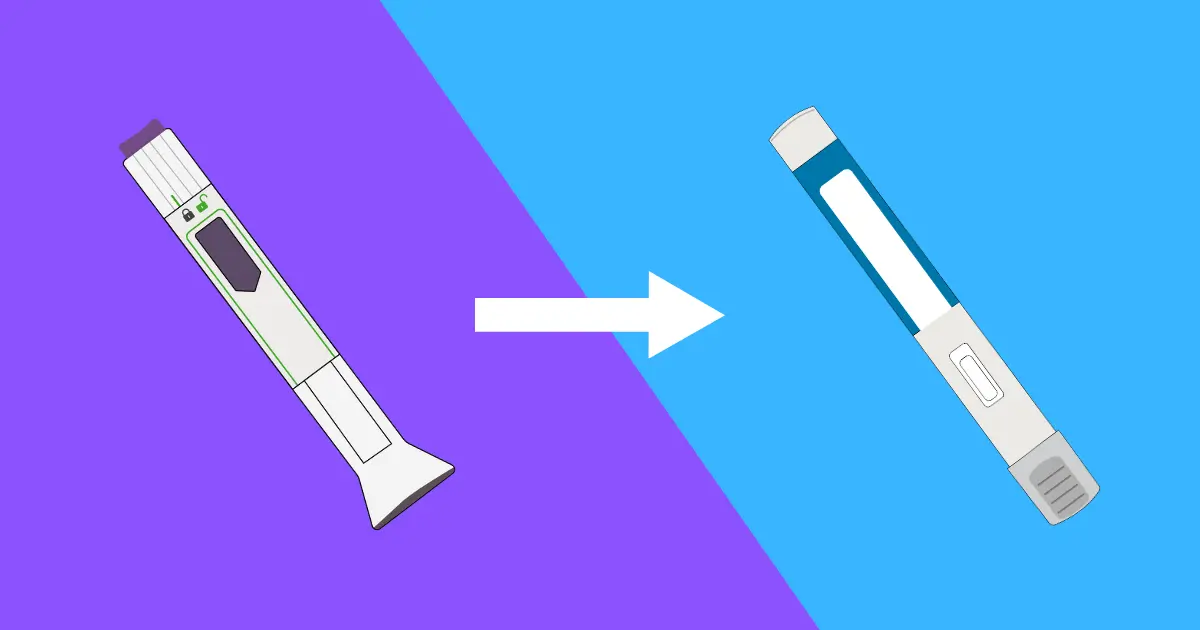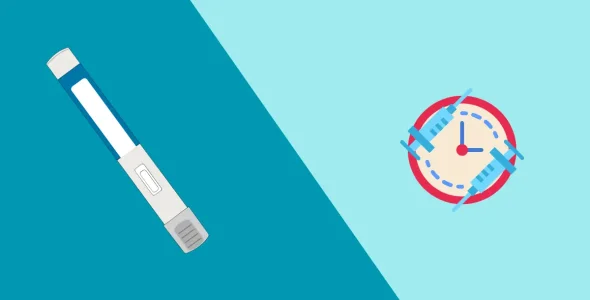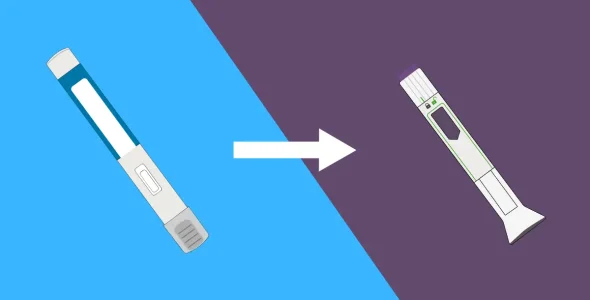Switching from tirzepatide to semaglutide dosage guide
Key highlights
- Tirzepatide and semaglutide are innovative medications used to treat individuals with type 2 diabetes mellitus and obesity.
- Switching from tirzepatide to semaglutide is not an overnight process. It should be done under the supervision of your healthcare professional to ensure safety and avoid potential side effects.
- Patients usually switch from tirzepatide to semaglutide due to the high cost, insurance coverage, supply shortages, and side effects.
- Always start with the lowest recommended starting dose, even if you were on a high dose of tirzepatide, and increase the dose gradually to help your body adjust.
- Temporary side effects such as nausea, vomiting, diarrhea, and constipation can occur during the transition phase, but they subside with time.
Over the last several years, medications that act on natural gut hormones, such as GLP-1 (glucagon-like peptide 1) and GIP (glucose-dependent insulinotropic polypeptide) receptor agonists, have revolutionized the treatment of type 2 diabetes mellitus and obesity. These medications help with type 2 diabetes while also working on your brain and digestive system to control your appetite, support weight loss, and lower the risk of heart-related diseases.
Semaglutide, marketed under the brand names Ozempic, Wegovy, and Rybelsus, is a GLP-1 agonist available in various forms, including weekly injections (Ozempic for diabetes and Wegovy for obesity) and daily oral tablets (Rybelsus). Tirzepatide (Mounjaro and Zepbound) is a dual GLP-1/GIP receptor agonist approved by the FDA for managing blood sugar levels (Mounjaro) and chronic weight management (Zepbound).
If you are currently on tirzepatide, a common question may arise: Can I switch from tirzepatide to semaglutide, and if yes, how can I do it safely and effectively?
There are several reasons to switch medications, including high cost, potential side effects that persist over time, supply shortages, personal response to the medication, and inadequate insurance coverage. However, semaglutide and tirzepatide are not interchangeable. Both medications have different mechanisms of action and dose formulations. Therefore, a safe switch from tirzepatide to semaglutide is never improvised. It requires a thoughtful plan in partnership with your doctor.
In this comprehensive article, we will explore the various reasons for switching medications, the key differences between the medications, what to expect during the transition, and why medical supervision is necessary.
Tirzepatide vs. semaglutide: Understanding the key differences
While both medications (tirzepatide and semaglutide) belong to the same incretin family, they are not identical. The key difference between these medications includes the following:
Mechanism of action
Semaglutide (Ozempic, Wegovy, and Rybelsus) is an FDA-approved GLP-1 receptor agonist. This medicine targets GLP-1 receptors in the gut and brain and activates them. Activation of GLP-1 receptors causes appetite suppression, reduces glucagon secretion, boosts insulin secretion (in a glucose-dependent manner), and slows down gastric emptying. These effects collectively make semaglutide effective for managing blood glucose levels and supporting weight loss.
In contrast, tirzepatide, an active ingredient of Mounjaro and Zepbound, is a dual agonist of the GLP-1 and GIP receptors. This medication mimics the activity of both incretin hormones. Due to its dual action, trizepatide offers added benefits beyond those of GLP-1 receptor agonists. This medication works by stronger appetite suppression, increasing your weight loss potential more than other GLP-1 medications, and improving overall metabolic health.
Efficacy for weight loss and glycemic control
Both semaglutide and tirzepatide are highly effective in improving your blood sugar level and supporting weight loss. However, some clinical studies suggest that tirzepatide is often more effective than other weight loss medications. According to SURMOUNT 5 clinical trial, people taking tirzepatide lost an average of 20.2% of their body weight, while those taking semaglutide lost 13.7% after 72 weeks. Tirzepatide is also more effective in managing blood sugar levels than semaglutide.
According to these clinical trials, people taking tirzepatide respond more positively to treatment and experience more significant weight loss and blood sugar control than those taking semaglutide.
FDA-approved uses
Semaglutide and tirzepatide are FDA-approved medications. The FDA-approved uses of these medications include the following:
FDA-approved uses of semaglutide (Ozempic, Rybelsus, and Wegovy):
- Semaglutide (Ozempic and Rybelsus) improves blood sugar levels in adults with type 2 diabetes mellitus.
- Ozempic also helps lower the risk of various cardiovascular events and kidney disease in adults with type 2 diabetes mellitus and with cardiovascular diseases.
- Wegovy is an FDA-approved GLP-1 medication indicated as an adjunct to a reduced-calorie diet and increased physical activity for chronic weight management in patients who are obese (BMI > 30) and overweight (BMI > 27) with at least one obesity related issue, such as hypertension or dyslipidemia.
- Wegovy also reduced the risk of major cardiovascular events in adults who are overweight or have known cardiovascular diseases such as hypertension.
- Wegovy was recently approved for the treatment of serious liver disease, known as ‘MASH’, in adults with moderate-to-advanced fibrosis.
FDA-approved uses of tirzepatide (Mounjaro and Zepbound):
- Mounjaro is an FDA-approved dual receptor agonist used to treat blood sugar levels in individuals with type 2 diabetes mellitus.
- Zepbound is used to treat individuals who are obese ( BMI > 30) or overweight (BMI > 27) with obesity-related conditions such as hypertension and hypercholesterolemia. It’s also FDA-approved for the treatment of moderate to severe obstructive sleep apnea in adults.
Dosing and administration
Both semaglutide and tirzepatide are given as once weekly subcutaneous injections, usually in the abdomen, thigh, or upper arm. However, despite these similarities, the dosage and formulation of these medications are different. There is no dose-to-dose equivalence between the two medications.
Wegovy and Ozempic are available as injectable pens, while Rybelsus is available as an oral tablet. Typically, the starting dose of semaglutide is 0.25 mg weekly, with a gradual increase according to the patient’s body response. Maintenance doses range from 0.5 mg to 2.0 mg weekly (Ozempic) for diabetes and up to 2.4 mg weekly (Wegovy) for weight management. Dosage and administration of semaglutide (Ozempic, Wegovy, and Rybelsus) is as follows:
Semaglutide dosing and administration
| Brand name | Approved dose(s) | Route & administration |
|---|---|---|
| Ozempic® (injectable) | 0.25 mg once weekly (initiation) → increase to 0.5 mg weekly; may escalate to 1.0 mg weekly; maximum approved: 2.0 mg weekly | Subcutaneous injection into abdomen, thigh, or upper arm. Rotate injection sites. Once weekly, on same day each week. |
| Wegovy® (injectable) | Escalating weekly doses: 0.25 → 0.5 → 1.0 → 1.7 mg → maintenance 2.4 mg weekly | Subcutaneous injection, once weekly, rotating injection sites (abdomen, thigh, upper arm) |
| Rybelsus® (oral tablets, semaglutide) | Two formulations: • R1: 3 mg → increase to 7 mg → can increase to 14 mg • R2: 1.5 mg → increase to 4 mg → can increase to 9 mg | Oral administration: must be taken on empty stomach, with no more than 4 oz water, and wait at least 30 minutes before food, drink, or other oral medications |
Tirzepatide (Mounjaro and Zepbound) is available as an injectable pen. Zepbound vials are also available through LillyDirect. This medication is typically started at 2.5 mg weekly and gradually increased every 4 weeks as tolerated. The maintenance doses range from 5 mg to 15 mg weekly, depending on response and tolerability. Dosage and administration of tirzepatide are as follows:
Tirzepatide dosing and administration
| Indication | Dose | Schedule | Notes |
|---|---|---|---|
| Weight Loss (Zepbound) | 2.5 mg | Once weekly (Weeks 1–4) | Starting dose; not for weight loss efficacy |
| 5 mg | Once weekly (Week 5 onward) | First step-up dose | |
| 7.5 mg (optional step) | Once weekly (≥4 weeks on 5 mg) | If further weight loss needed | |
| 10 mg | Once weekly | Recommended maintenance dose | |
| 12.5 mg (optional step) | Once weekly (≥4 weeks on 10 mg) | If further titration is needed | |
| 15 mg | Once weekly | Maximum dose | |
| Type 2 Diabetes (Mounjaro) | 2.5 mg | Once weekly (Weeks 1–4) | Starting dose; not for glycemic control |
| 5 mg | Once weekly (Week 5 onward) | Initial therapeutic dose | |
| 7.5 mg | Once weekly (≥4 weeks on 5 mg) | Titrate if needed | |
| 10 mg | Once weekly | Intermediate dose | |
| 12.5 mg | Once weekly (≥4 weeks on 10 mg) | Titrate if needed | |
| 15 mg | Once weekly | Maximum dose |
Side effect profiles
Both semaglutide and tirzepatide have similar side effects. The most common side effects include:
- Nausea
- Vomiting
- Diarrhea
- Constipation
- Headache
- Heartburn
- Abdominal pain or discomfort
These symptoms typically appear during the initiation of medication or during the dose escalation period and subside over time. Both semaglutide and tirzepatide are linked to these gastrointestinal side effects, but the likelihood is higher with tirzepatide, especially at higher doses.
According to clinical trial results, users of tirzepatide had nearly a threefold higher risk of gastrointestinal issues, while users of semaglutide had less than a twofold higher risk compared to those receiving a placebo. Both drugs can cause stomach-related problems, but these side effects tend to occur more often in people taking tirzepatide.
However, the individual responses vary. Some people may tolerate tirzepatide better, while others tolerate semaglutide with fewer problems.
Cardiovascular benefits
Semaglutide (Wegovy and Ozempic) has been shown to have cardiovascular benefits. Multiple large-scale clinical trials have shown that semaglutide significantly reduces the risk of major adverse cardiovascular events (MACE), including heart attack, stroke, and cardiovascular death. Additional benefits of semaglutide include reductions in body weight, systolic blood pressure, and inflammatory markers, all of which contributed to improved cardiovascular outcomes. In contrast, tirzepatide shows promising cardiovascular potential, but these effects are still under ongoing clinical research.
Cost and insurance coverage
Cost and insurance coverage are often major factors in deciding between semaglutide and tirzepatide. Prices of the medications vary depending on your insurance coverage, copays, coinsurance, deductibles, and eligibility for manufacturer savings programs.
Semaglutide saving and insurance support:
If your commercial insurance covers Ozempic, you can pay as little as $25 for a 1-month to 3-month supply of Ozempic for up to 48 months. However, if you are not commercially insured, you can pay $499 per month through NovoCare Pharmacy.
For commercially insured patients with coverage for Wegovy, the savings card may reduce your monthly cost to $0, with a maximum savings limit of $225/month. In contrast, uninsured patients pay $499 per month for a supply of Wegovy. You can also purchase Wegovy without insurance for $499 per month through NovoCare Pharmacy.
Tirzepatide savings and insurance support:
Commercially insured patients using the Mounjaro or Zepbound® Savings Card may pay as little as $25 per month if their insurance covers the medication. However, the savings card program provides savings of up to $150 per month with an annual cap. If insurance doesn’t cover Zepbound, the card may still provide savings of up to $469 per month. For those paying cash, LillyDirect offers Zepbound vials for $499 per month.
Why consider switching from tirzepatide to semaglutide?
Here are some common reasons why patients may consider switching from tirzepatide to semaglutide.
Intolerable side effects of tirzepatide
Even though tirzepatide is generally well-tolerated, this medication is a dual GLP-1/GIP receptor agonist, which can sometimes cause stronger and more persistent or severe GI side effects that do not subside with time. In contrast, semaglutide is a single GLP-1 receptor agonist that causes fewer side effects than tirzepatide and is well-tolerated. Therefore, many patients consider switching from tirzepatide to semaglutide due to these intolerable side effects.
Insurance coverage or cost
Tirzepatide is comparatively new in the market and can sometimes be more expensive or less frequently covered by insurance plans than semaglutide. As semaglutide is approved for more uses than tirzepatide, insurance coverage may be more likely for some patients.
Individual response to the medication
The response to these medications varies from person to person. Tirzepatide often shows greater efficacy than semaglutide. Some patients may experience a plateau or find that semaglutide works better for them due to their genetics, lifestyle, and other personal factors.
Preference for oral option
Semaglutide is available in the form of oral pills (Rybelsus), which is great for those who don’t want injections, while tirzepatide comes in the form of an injection.
Specific health conditions and comorbidities
For patients with certain health issues such as cardiovascular diseases and kidney diseases, semaglutide has been clinically proven to reduce the risk of cardiovascular events and kidney disease. In contrast, tirzepatide lacks significant clinical data.
Long-term tolerability and sustainability
Some patients may find semaglutide more tolerable over the long term due to its fewer side effects and various long-term health benefits, or due to its simple titration schedule.
Availability issues
Tirzepatide is a new medication with on-and-off supply shortages, making it difficult for patients to access their medications at times. Semaglutide may be more easily available for some patients, which helps with treatment continuity. Therefore, during a shortage of tirzepatide, patients may switch to semaglutide.
How to switch safely: Step-by-step guide
Switching from tirzepatide to semaglutide is never a do-it-yourself decision. It should be done under the supervision of your healthcare provider. Only your healthcare professional can determine whether switching is appropriate for you. They will assess your medical history, your current response to the medications, potential drug interactions, and side effects, and create a personalized plan based on your body’s response.
Pre-switch assessment by your doctor
Before switching, your doctor will do an assessment. They will review the current efficacy of the medicine treatment and may ask the following questions. Are you losing weight or not? Is your sugar under control? They will also discuss the reasons for switching, such as intolerable side effects, high costs, or a plateau.
Your doctor will assess your overall health status and medical history to make sure that the new medication is safe for you.
They will openly discuss your goals with you before switching the medication and personalize your treatment according to your blood sugar control and weight loss needs.
Timing the transition
Timing is very important when switching from tirzepatide to semaglutide. There is no need to take a long break to wash out one drug. Both tirzepatide and semaglutide have long half-lives and stay in the body for several days to weeks. Therefore, it is not necessary to wash out one drug before starting the other.
Your doctor will most commonly start the new medication (semaglutide) one week after the last dose of tirzepatide, often on your regular injection day. This helps keep your routine consistent and avoid a long gap between your treatments.
When to switch from tirzepatide to semaglutide
| Time passed since the last dose of semaglutide | When to take the first dose of tirzepatide |
|---|---|
| 1 day | In 6 days |
| 2 days | In 5 days |
| 3 days | In 4 days |
| 4 days | In 3 days |
| 5 days | In 2 days |
| 6 days | In 1 day |
| 7 or more days | Today |
However, if you are experiencing severe side effects from tirzepatide, your doctor may advise you to wait until your symptoms settle down before starting semaglutide. This helps reduce the risk of side effects, which can sometimes worsen during the dose increment.
Dosage adjustment and titration for semaglutide
When switching from tirzepatide to semaglutide, it is generally recommended to start with the lowest FDA-approved semaglutide dose (0.25 mg) once weekly, even if you were on a higher tirzepatide dose. Your healthcare provider will increase the dose slowly and gradually to help your body adjust and to avoid the risk of side effects.
The titration schedule for Ozempic and Wegovy is as follows:
Ozempic (for type 2 diabetes or glycemic control):
- Weeks 1-4: 0.25 mg once weekly (starter dose, not yet effective for blood sugar, but helps your body adjust and reduces the risk of potential side effects.)
- Weeks 5-8: 0.5 mg once weekly
- Weeks 9-12: 1.0 mg once weekly
- Weeks 13 onwards: 2.0 mg once weekly (if further glycemic control is needed). This is the maximum dose of Ozempic.
Wegovy (weight management):
- Weeks 1-4: 0.25 mg once weekly
- Weeks 5-8: 0.5 mg once weekly
- Weeks: 9-12: 1.0 mg once weekly
- Weeks 13-16: 1.7 mg once weekly if needed.
- Weeks 17 onwards: 2.4 mg once weekly if further weight loss is needed (maximum dose).
These are the standard FDA-approved titration schedules for Ozempic and Wegovy. However, your healthcare provider will personalize your titration schedule according to your body’s response and your goals.
While there are no official dose conversion guidelines, conversion of doses between tirzepatide and semaglutide may look like:
Tirzepatide to Semaglutide dose conversion
| Tirzepatide dose | Semaglutide dose |
|---|---|
| 2.5 mg | Consider starting semaglutide at 0.25 mg to 0.5 mg once weekly |
| 5 mg | Consider starting semaglutide at 1 mg to 1.7 mg once weekly |
| 7.5 mg | Consider starting semaglutide at 1.7 mg to 2 mg once weekly |
| 10 mg | Consider starting semaglutide at 1.7 mg to 2.4 mg once weekly |
| 12.5 mg | Consider starting semaglutide at 1.7 mg to 2.4 mg once weekly |
| 15 mg | Consider starting semaglutide at 1.7 mg to 2.4 mg once weekly |
What to expect during the transition
Switching from tirzepatide to semaglutide is not an easy step and should be supervised by your healthcare provider.
Some patients experience gastrointestinal symptoms such as nausea, vomiting, diarrhea, and constipation when they start semaglutide, even if they tolerated tirzepatide. These side effects are usually temporary and often improve as your body adjusts.
If you are taking these medications for type 2 diabetes, your doctor may ask you to monitor your blood sugar levels more often during the first week after switching to the medication.
Some people experience their weight loss progress stalling after switching medications. This does not mean that the medication is not working properly. It means your body needs time to adjust to the new medication.
Do not use both medications simultaneously
It is essential to understand that semaglutide and tirzepatide should not be taken simultaneously, as both medications work similarly to affect blood sugar levels, appetite, and digestion. Consuming these medications together does not mean they will double the benefits. It is very dangerous and can cause adverse effects.
What to do if you were on a high tirzepatide dose
If you were on a high tirzepatide dose, you usually don’t start semaglutide at a high dose right away. Your healthcare provider will likely start with the lowest recommended dose of semaglutide (0.25 mg) and gradually increase the dose as needed. This is important because:
- It gives your body time to adjust to the new medication
- Starting at a low dose helps reduce the risk of severe gastrointestinal side effects that typically occur with high doses of the medication.
- It allows your doctor to monitor the tolerance and effectiveness of medication before increasing the dose.
Managing side effects during the switch
You can manage the side effects in the following ways.
Common transition side effects
When switching from tirzepatide to semaglutide, some side effects may reappear, especially during the start of medication or during dose escalation. These side effects include:
- Nausea
- Fatigue
- Rebound hunger
- Nausea
- Fullness
- Burping
- Diarrhea
- Constipation
Follow these steps to avoid these side effects:
- Eat smaller meals with protein
- Avoid greasy or spicy foods
- Keep yourself hydrated
- Light physical activity
These side effects are usually temporary and subside on their own. However, if you are experiencing severe and intolerable side effects that don’t subside over time, consult your healthcare provider. They will guide you and adjust the dose.
Both tirzepatide and semaglutide slow gastric emptying and can affect the absorption of oral medications. These medications also increase the risk of hypoglycemia if taken with other glucose-lowering agents such as metformin. It is important to note the box warning:
- Don’t use the medication if you have thyroid cell tumors, MEN2 syndrome, or a family history of medullary thyroid cancer.
- This medication is not recommended for individuals with type 1 diabetes mellitus
- Avoid using this medication during pregnancy or breastfeeding and when you are trying to conceive.
This information is for educational purposes only, not medical advice. Always consult your healthcare professional before starting any treatment.
How to minimize discomfort
The following simple habits can make your transition easier. These include:
- Eat smaller meals and chew them slowly so they can be digested easily.
- Include a small portion of protein with each meal. Add foods like nuts, legumes, peas, white poultry, fish, and whole grains to your diet.
- Avoid greasy, spicy, processed, and fried foods.
- Engage in light physical activity to avoid bloating.
- Get enough sleep to avoid fatigue.
- Ask your doctor to prescribe the over-the-counter medication to overcome side effects if required.
Will you lose progress? What to expect
Switching from tirzepatide to semaglutide does not mean you will lose all your progress. Factors that influence your progress include the following:
Individual variability
Switching medications does not work the same for everyone. Every person’s body responds differently to the medication. Some people continue to lose weight smoothly even after switching medications, while others may notice a slower pace at first or regain some of the weight they have lost. Factors such as genetics, lifestyle, and other conditions play a significant role.
Weight loss continuation
Semaglutide is highly effective for weight management. Many people maintain or continue losing weight after switching to medication. However, the speed of progress may differ compared to tirzepatide.
Blood sugar changes
If you are using tirzepatide for managing blood sugar levels, your doctor will adjust the semaglutide dose to keep your blood sugar level in the normal range.
Patience and adherence
Initially, your healthcare provider will start with a low dose of semaglutide and gradually increase it according to your body’s response and tolerance. This process takes time for your body to adjust, and for semaglutide to reach full effect. Therefore, consistent adherence to the new medication and lifestyle recommendations will help you achieve your weight loss and optimal sugar levels.
Continued lifestyle commitment
It is important to note that both medications, tirzepatide and semaglutide, are most effective with a healthy lifestyle. These medications are effective in managing blood sugar levels and promoting weight loss, but they work best when combined with healthy eating habits, regular physical activity, and behavioral modifications.
Step-by-step checklist for switching from tirzepatide to semaglutide
Follow this checklist before switching from tirzepatide to semaglutide.
- Book a consultation with your healthcare provider, and inform them of the last date of your tirzepatide dose. Share your current dosage schedule, any potential side effects you are experiencing, and your goals for switching.
- Decide on the timing for taking semaglutide. For example, one week after taking your last tirzepatide dose.
- Follow your doctor’s guidelines, which will typically start with the lowest recommended dose of semaglutide and increase it gradually over time. Your doctor will provide you with a titration calendar, which allows you to increase the dose safely.
- Ensure that you have the necessary insurance coverage for the medication. Sign up for the savings cards if you are eligible.
- Eat smaller meals, avoid fatty foods, and stay hydrated to avoid gastrointestinal side effects.
- Schedule a follow-up visit with your provider 2-4 weeks after starting the medication to follow up on your progress. Your doctor will adjust the dose according to your response to the treatment.
FAQs
How long after my last tirzepatide dose should I start semaglutide?
You can start semaglutide (Ozempic, Wegovy, and Rybelsus) one week after the last tirzepatide (Mounjaro and Zepbound) dose. Both medications are long-term GLP-1 receptor agonists and require a full week for safe switching to avoid overlap and reduce the risk of side effects.
Is switching from tirzepatide to semaglutide safe?
Yes, switching from tirzepatide to semaglutide is generally safe when done under the supervision of an experienced healthcare provider. Since they are not dose-equivalent, semaglutide is started at a low dose and its dosage is increased gradually.
Will I lose more weight if I switch from tirzepatide?
Not necessary, as tirzepatide has shown greater average weight loss than semaglutide. Some people may experience similar or more weight loss on semaglutide, especially if they have a weight loss plateau or are experiencing side effects.
What are the main reasons people switch from tirzepatide to semaglutide?
People may switch from tirzepatide to semaglutide due to the following main reasons.
- Persistent or severe gastrointestinal side effects
- Insurance coverage
- Supply shortage of tirzepatide
- Preference for oral medication (Rybelsus) over injectable medications
- Long-term cardiovascular benefits of semaglutide
What semaglutide dose should I start with?
Your healthcare provider will typically start your treatment at a low dose of semaglutide (0.25 mg once weekly) and gradually increase the dose every 4 weeks to reduce the risk of gastrointestinal side effects.
Can I switch back if semaglutide doesn’t work?
Yes, you can switch back to tirzepatide if you don’t get the expected weight loss or sugar control results or experience side effects. However, it is important to start tirzepatide at the starting dose and gradually increase the dose according to your body’s response. Remember, you can not switch directly without first consulting with your healthcare provider, who will provide you with an appropriate dosing schedule and treatment plan.
Will I regain weight during the transition?
It’s possible. You may experience slight weight regain when switching from tirzepatide to semaglutide, especially if there is a gap between the treatments or if semaglutide is started at a lower dose. However, maintaining a healthy lifestyle and a well-planned diet can help you prevent weight regain.
Do I need a washout when switching from Mounjaro to Wegovy?
No, a washout period is not needed when switching from Mounjaro to Wegovy. You can start taking semaglutide 1 week after your last Mounjaro dose under the supervision of your healthcare provider.
What dose of semaglutide do I start if I was on high-dose tirzepatide?
If you are on a high dose of tirzepatide, your healthcare provider will usually start semaglutide at a lower dose (0.25 mg) to help your body adjust and reduce the risk of side effects. They will gradually increase the dose according to your body’s tolerance.
How soon will semaglutide “kick in”?
Semaglutide will start working within a few weeks, with noticeable effects on appetite and blood sugar control often seen around the 4th week. However, the full therapeutic effect for weight loss and sugar control will develop gradually over 3-6 months as the dose increases.
What side effects should I watch for?
The common side effects of semaglutide include nausea, vomiting, diarrhea, constipation, and abdominal discomfort. However, these side effects are temporary and subside gradually over time. Rare but serious side effects of semaglutide include pancreatitis, gallbladder problems, and allergic reactions. If you experience these side effects, consult your healthcare provider immediately.
Can I take semaglutide and tirzepatide at the same time?
No, you cannot take semaglutide and tirzepatide together because these medications work in similar ways, resulting in increased risk of side effects without added benefits. Therefore, always discuss any changes with your healthcare provider before making a switch or adjusting the dose.
Conclusion
Switching from tirzepatide to semaglutide is not uncommon, but it should be done under the supervision of an experienced healthcare provider. Both medications belong to the incretin family, but have different mechanisms of action, dosing, FDA-approved uses, and side effect profiles. Tirzepatide provides greater weight loss and improved sugar control compared to semaglutide, while semaglutide offers proven cardiovascular benefits.
Many people consider switching from tirzepatide to semaglutide due to persistent gastrointestinal side effects, insurance limitations, cost, and supply shortage. Regardless of these reasons, this process requires careful planning under the supervision of your healthcare provider. Always start with a low dose of semaglutide (0.25 mg), even if you were previously at a high dose of tirzepatide, titrate it slowly, and monitor the results and side effects regularly, in partnership with your doctor.
Most patients continue to see progress after switching the medication, especially when they remain consistent with treatment along with a healthy lifestyle. Consult your doctor before making a switch to get a personalized treatment plan.










